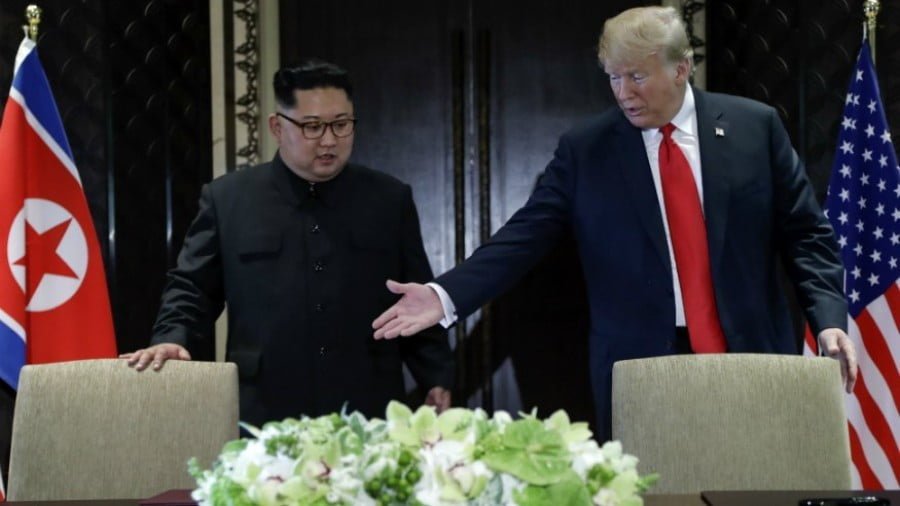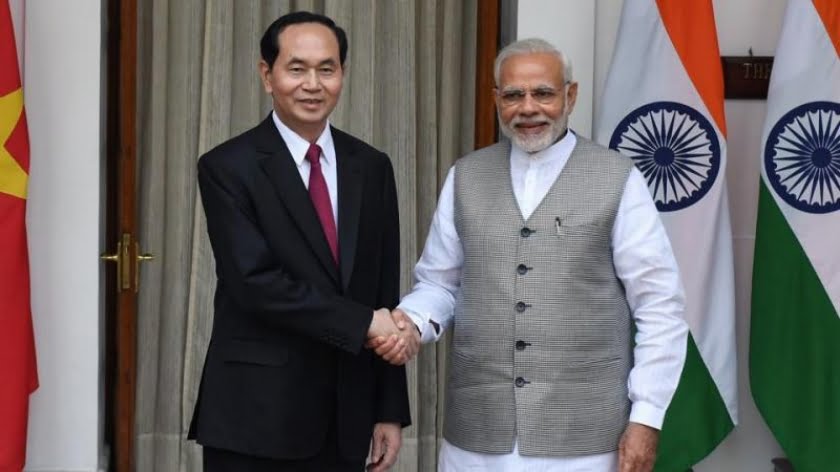The Trump-Kim Deal Is the First Example of the “New Washington Consensus”
The US is rolling out a new approach for managing the emerging Multipolar World Order, and the Trump-Kim deal is expected to be its centerpiece in showing other countries what the New Washington Consensus entails.
America’s Response To Multipolarity
The successful Trump-Kim Summit in Singapore saw the two leaders agree to begin the process of North Korea’s denuclearization and to strengthen their relations with one another. It’ll undoubtedly be a long process despite what Trump said about his expectation that it’ll move along real fast, but the point of this analysis isn’t to critique the language used by either leader or the words included within the document that they both just signed. Rather, it’s much more constructive to explain what the US is trying to achieve from all of this in a grand strategic sense and its overall relevance in the context of the New Cold War. The US is well aware that it’s lost its unipolar edge over the years as the emerging Multipolar World Order has become inevitable through the coordinated efforts of Russia and China, though this statement of fact doesn’t mean that America’s global hegemony is anywhere close to finished.
In response to this systemic challenge, the US has been pressed into pioneering a new multilateralism through its “Lead From Behind” (LFB) model of regional management which sees subordinated Great Powers such as India and Japan “contracted” to advance American foreign policy goals in which they’re led to believe that they have a shared interest. The Great Power constellation that the US is creating in order to “contain China” runs from Japan to Indonesia and India, with the smaller- and medium-sized states in between them the object of competition between the US’ LFB partners and the People’s Republic. This strategic network is expected to be economically maintained through the Indo-Japanese “Asia-Africa Growth Corridor” (AAGC) that its founders want to complement, but also compete with, China’s One Belt One Road (OBOR) global vision of New Silk Road connectivity. The main selling point is that it’s supposed to provide an alternative to China for developmental assistance and trading ties.
The Illusion of Choice
It’s that prevailing idea of presenting a choice to China that’s expected to become the most attractive characteristic of the AAGC, which itself can be conceptualized as the economic front for the US’ LFB strategy of new multilateralism in confronting the challenge of the emerging Multipolar World Order. Unipolarity is fading, but it’s not completely gone, at least not yet, and the previous world system marked by the Washington Consensus of American-centric neoliberal trading networks still persists. In fact, a polar reorientation of sorts is in the process of taking place whereby China is replacing the US as the center of globalization while the US is replacing China as the new champion of protectionism. In fact, the US’ Indo-Japanese allies are also somewhat protectionist in the sense that they have yet to fully open their markets to the unrestricted entrance of Chinese goods and services out of the fear of their mutual neighbor overwhelming their economies, despite it already being their top trading partner.
The concept at play is that the US wants the AAGC to function as a semi-protectionist Afro-Pacific trading bloc whose main appeal is that it provides a credible alternative to China, though the credible part of this equation has yet to be seen. Most of the “Global South” is already working on deepening its OBOR connectivity with China due to the expectation that they’ll receive win-win benefits by throwing their lot in with Beijing’s model of Silk Road Globalization, believing that this new framework will provide a more balanced and equal stake for them in the emerging world system than tying their fates to the New Washington Consensus, which is perceived as just a rebranding of the old system that exploited so many of them. The US’ Indo-Japanese LFB Great Power proxies are in essence providing a multipolar front to the perpetuation of an originally unipolar system whose strings are still pulled by the US through its management of this reformed systemic model.
Not only does this particular observation cast doubts on the credibility and ultimate success of the AAGC, but so too does the obvious fact that India and Japan are entering the connectivity game much later than China is and therefore can only position themselves as the “anti-China”, or in other words, embrace a “negative identity” of being opposed to something else instead of a positive/constructive one in building something new (seeing as how this framework is pretty much just retaining a reformed version of the old system). What Trump urgently needs in order to more convincingly sell this model to the rest of the world is a credible success story that showcases how the New Washington Consensus can deliver results to those who are trying to “balance” China, which is where the American-North Korean rapprochement comes in because of the potential that it has for doing just that if everything goes according to plan.
Setting Up The Summit
As it currently stands, China has monopolized a large chunk of its neighbor’s economy, not out of any malicious or neo-imperial intentions but simply because it’s been the only lifeline to the “Hermit Kingdom” since the Soviet Union collapsed and Moscow cut off all of its previous aid to the country. For all practical intents and purposes, China controls the North Korean economy, an open secret that’s known to even the most casual observers even if it’s “politically incorrect” to publicly say and is regularly denied by Beijing. The never-ending international sanctions had the effect of scaring off most other investors, and Russia entered the game way too late in the past couple of years to make any tangible difference. Moreover, by the time that Moscow got interested in North Korea’s economic potential as a transit state connecting the investment-hungry but energy-rich Far East region with cash-flush but energy-poor South Korea, international sanctions became tighter, and Russia itself also signed onto them together with China.
The cumulative effect of this latest development, particularly in terms of China’s honest participation in the latest round of sanctions (for reasons related to its unease at having a nuclear-armed neighbor play the “useful idiot” in bringing American anti-missile infrastructure closer to its borders), was that North Korea had little choice other than to negotiate with the US and reconsider its nuclear capabilities. Faced with the real fear of experiencing another nationwide famine such as the one that reportedly struck the country in the 1990s, Chairman Kim’s immediate interests were purely economic, and he painfully came to perceive of his “big brother” in the north as a Great Power who isn’t above playing political games in pursuit of its self-interests. In China’s defense, its global strategy of multipolarity was being endangered by what it considered to be Kim’s recklessness in engaging in so many nuclear and missile tests, but regardless, the bonds of trust were irrevocably broken between these two.
That, however, doesn’t mean that North Korea regards China as an “enemy”, but just that the young Kim had a rude awakening in terms of how the real world works, learning first-hand that slogans of ideological solidarity about a shared “communist struggle” don’t compensate for his country’s disadvantageous position as a pawn on the Hyper-Realist “19th-Century Great Power Chessboard”. Disheartened by this realization and likely feeling some natural resentment towards his former benefactors, Kim decided to enter into unprecedented denuclearization talks with the US, though prudently taking care to involve China in all manner of his consultations so as not to inadvertently make an actual enemy out of it given how easily this very sensitive situation could have turned into a fast-moving security dilemma between Pyongyang and Beijing had he not had the wisdom to do so. Seeking sanctions relief and a “counterbalance” to China, Kim ultimately agreed to the Singapore Summit with Trump.
Hollywood Hopes
Having predictably been briefed on the psychological-economic factors that drove Kim to come to the Singapore Summit and in all likelihood agree beforehand on what the outcome of this historic event would be, Trump came to the event with the fullest of confidence but also with a secret ace up his sleeve to sweeten the deal that he was about to publicly clinch with his counterpart. It’s now been revealed that Trump showed Kim a Hollywood-style four-minute video extolling the economic and developmental benefits that North Korea could receive if its Chairman chooses the right path at this once-in-a-lifetime crossroad that the film dramatically hints he was fated to appear at. Evidently, Kim must have really enjoyed the promising message that was conveyed because all of his body language immediately after his private viewing of this film with Trump during their one-on-one meeting was exceptionally positive and radiated happiness, sincerity, and confidence as he agreed to advance his country’s denuclearizati
The futuristic footage of North Korea experiencing “First World”-level development after the successful implementation of a forthcoming denuclearization deal is probably premature and would take some time to enter into effect even under the most ideal and fast-moving of conditions, but it’s this promise of a materialistically better life for his country and its citizens that must have ultimately convinced Kim to go forward with this plan. There are of course very serious concerns that Bolton and Pence’s invocation of the so-called “Libyan model” was a bad omen presaging Kim’s eventual overthrow and assassination just like what happened to Colonel Gaddafi after agreeing to something similar roughly a decade and a half ago, though there’s also the chance that the US has an even greater self-interest in actually keeping its word and showcasing North Korea as a successful example of the New Washington Consensus, with the symbolism of this being all the more powerful given how much animosity had previously existed between these two countries prior to the summit.
https://youtu.be/A838gS8nwas
The US has more to gain in a grand strategic sense by protecting North Korea and doing good on its pledge to develop it into a “First World” state (taking advantage of its citizens’ low wages, the country’s rare earth mineral wealth, and its location between China and South Korea) than to turn it into a failed state like it did to Libya. China is strong enough to protect itself from a prospective North Korean collapse, which would mostly harm South Korea and possibly even Japan if it led to Pyongyang lobbying a few nuclear missiles at their capitals out of last-minute desperation prior to being destroyed, but China would have a comparatively more difficult time confronting would be the emergence of a credible alternative to OBOR, namely if North Korea was held up as the model of how beneficial it could be it other countries joined the New Washington Consensus. With one-time anti-American Kim as its literal poster boy, the soft power appeal would be tremendous.
Concluding Thoughts
There’s always the possibility that Trump has deceived Kim and that the US forced North Korea into strategic submission through what can only be speculated might have been a new military technology that compelled him to enter into a “dignified surrender” as per the public relations spectacle that’s presently unfolding, but it also can’t be overlooked that the US might actually surprise the world by keeping its word and turning North Korea into the centerpiece of the New Washington Consensus. Trump himself seemed to hint at this happening by putting his business reputation on the line after emphasizing North Korea’s real estate potential, which dovetails with the dramatic images of “First World” luxury that were shown to Kim after his private viewing of the Hollywood-style film designed to allay any remaining reluctances that he may have had going into the summit.
The US’ interlinked strategic and narrative modus operandi in responding to the challenges of the emerging Multipolar World Order is to present itself and its LFB (and especially AAGC) partners as a credible alternative to China and its OBOR, with specific (and likely decontextualized) attention being drawn to what will probably be framed as Beijing’s predatory financial practices and market monopolization motivations in order to win over more hearts, minds, and ultimately countries in this New Cold War competition that’s being fought largely over competitive connectivity. There’s no more symbolic of a country to advertise as the success of the New Washington Consensus than North Korea considering its storied history of sincere anti-Americanism since the moment of its founding, with the message being that any country can cooperate with the US in “balancing” against China if even Kim of all people chose this path for his countrymen.
This elaborated vision is wholly dependent on North Korea completely and irreversibly fulfilling its denuclearization pledge and the US subsequently honoring its side of the bargain by turning the country into an economic powerhouse. There’s plenty that can go wrong between now and then even under the best circumstances of both sides being sincerely committed to carrying out this game-changing quid pro quo, be it natural differences that might arise throughout the course of negotiations and implementation (to say nothing of those that might be externally provoked through a third party’s interference) or internal sabotage by one or the other’s “deep state” operatives, but as of now, both sides seem to have entered into this agreement in good faith. That being the case, in the event that the “best-case” scenario that they’re both aiming to actualize is achieved, then the economic embodiment of the American-North Korean rapprochement could change the entire global dynamic of the New Cold War.







